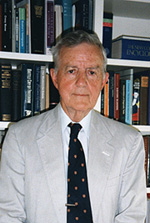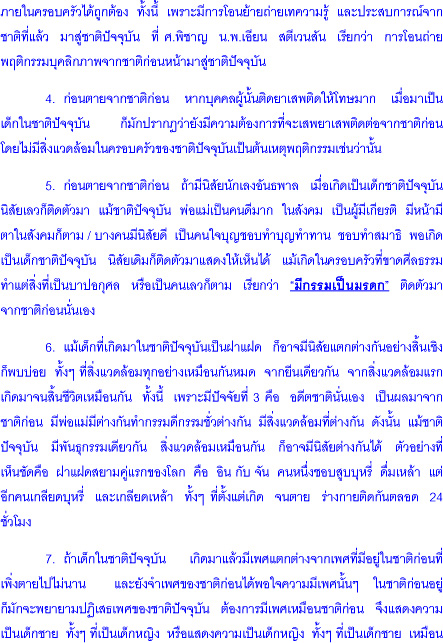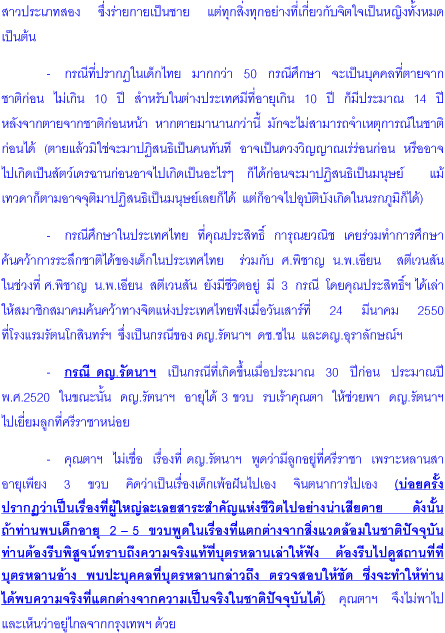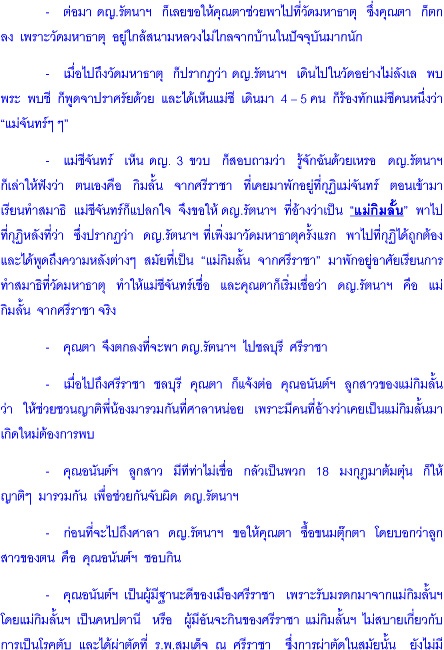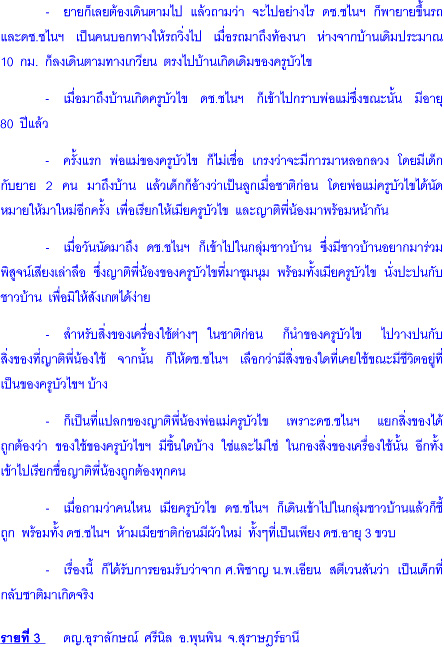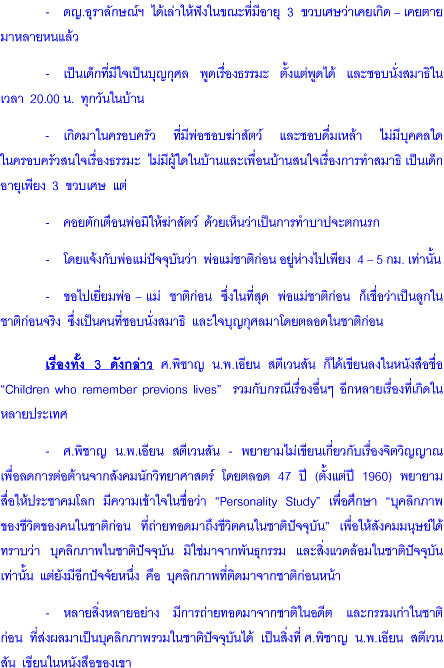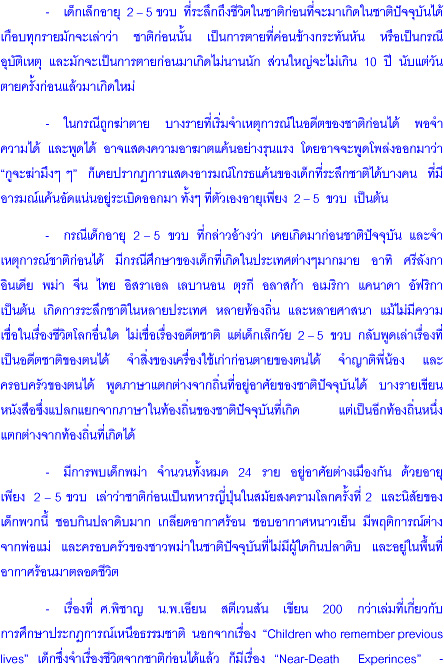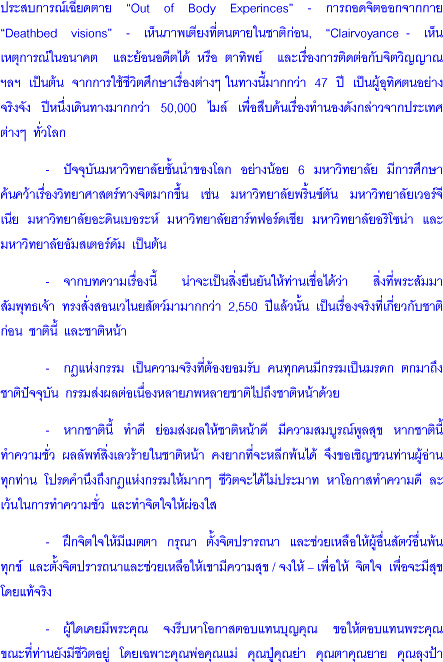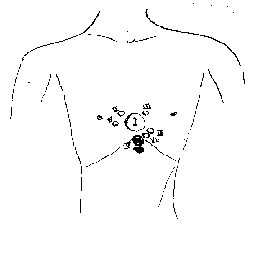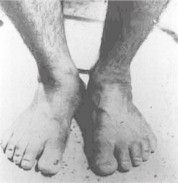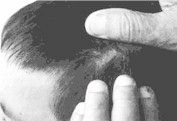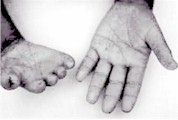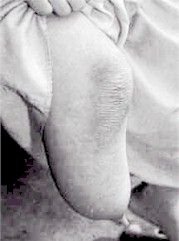เพื่อนของ ดร. ปาน่าเอ๋อจี๋ เป็นนักจิตวิทยาชาวญี่ปุ่น ก็มาพิสูจน์เรื่องนี้เช่นกันและกล่าวว่า "ปาน่าเอ๋อจี๋เป็นนักวิทยาศาสตร์
จึงใช้วิธีการทางวิทยาศาสตร์มาพิสูจน์เรื่องนี้ว่าเป็นเรื่องจริงหรือไม่ หรือว่าเป็นเพียงเรื่องแหกตาเพื่อหาเงินเท่านั้น เราได้ทดสอบข้อสงสัยทุก ๆ
ข้อที่เกิดขึ้น ในที่สุดก็สรุปได้ว่า การกลับชาติมาเกิดของอาปี่ มาเป็นอีซื่อยี่นั้น เป็นเรื่องจริง
แปลและเรียบเรียงจากเรื่อง "ฉวนเซิงฉีจี้ ของ "หยูหลิง
http://my.opera.com/dosgames/blog/show.dml/278573
webmaster - 13/9/08 at 15:33
เด็กหญิงสำเนียง ผู้ระลึกชาติได้ในประเทศไทย
เด็กหญิงสำเนียงกลับชาติมาเกิดใหม่ เธอคือ ปรานี ( น้อย ) สีเทา ณ ที่บ้านคอนสวรรค์ จังหวัดสุรินทร์
เดือนเมษายน พ.ศ. ๒๕๐๓
นายเที่ยง - นางเพชร สว่างผุย ได้ให้กำเนิดบุตรสาวคนแรก ตั้งชื่อว่า สำเนียง ในปี พ.ศ. ๒๕๓๕ นายเที่ยง มีอายุได้ ๕๕ ปี นางเพชร
มีอายุได้ ๕๓ ปี มีบุตรด้วยกันรวม ๘ คน ดังนี้
๑. เด็กหญิงสำเนียง ตายตั้งแต่อายุ ๘ ขวบ
๒. เด็กชายเจียงลม ตายตั้งแต่อายุ ๖ เดือน
๓.นางสำรอง
๔.นางสำลี
๕.นายสมพร
๖.นายละคร
๗.นางสาวไกรสร
๘. เด็กหญิงบังอร
ต้นเดือนกุมภาพันธ์ พ.ศ. ๒๕๑๐ สำเนียงมีอายุได้ ๘ ขวบ กำลังจะเข้าโรงเรียนในเดือนพฤษภาคม พ่อแม่ก็ได้ซื้อเครื่องแบบนักเรียนมาไว้ให้
เพื่อจะได้ใส่ไปโรงเรียน แต่ในบ่ายวันหนึ่ง มีคนขึ้นเอาลูกตาลอ่อน ที่อยู่ใกล้บ้านทางทิศใต้ ( เดี๋ยวนี้ยังอยู่ ) สำเนียงได้เก็บเอาลูกตาลมาหอบหนึ่ง
เอามาให้แม่ปอกให้กิน
ตกตอนกลางคืน เวลาประมาณตี ๑ ตี ๒ สำเนียงเกิดปวดท้องอย่างหนัก มีอาการเจ็บแน่นขึ้นเรื่อย ๆ พ่อกับแม่ได้หายาพื้นบ้านมาให้กินแต่ก็ไม่หาย
จนรุ่งสว่างก็ไม่ทุเลาสำเนียงได้บอกแม่ว่า ถ้าเจ็บอย่างนี้ตนคงไม่รอดแน่ และในที่สุดสำเนียงก็ทนไม่ได้ สิ้นใจไปในเช้าวันนั้นเอง
พอเวลาบ่ายก็เอาศพของสำเนียงไปฝังไว้ที่ป่าช้า ทางทิศตะวันตกของบ้านคอนสวรรค์ ก่อนเอาศพสำเนียงลงโลงนั้น
แม่ได้เอาขมิ้นผสมปูนป้ายไว้ที่หน้าอกของสำเนียงด้วย โดยคิดว่าหากลูกเกิดมาอีกจะได้มีเครื่องหมายบอกไว้ให้รู้ และเมื่อจะเอาศพของสำเนียงไปฝังนั้น
ศพยังไม่เย็นไม่แข็งเลย ยังมีความอุ่นอยู่เหมือนคนยังไม่ตาย จนบางคนว่าอย่าเพิ่งเอาไปฝัง เพราะบางทีสำเนียงอาจจะฟื้นมาอีก เพราะกายยังอุ่น ๆ อยู่
แต่บางคนก็แย้งว่า ตายไปแล้วไม่มีทางฟื้นหรอก ที่ยังอุ่นอยู่นั้นก็เพราะตายสด ๆ ไม่ได้เจ็บป่วยเป็นเวลานานจึงเป็นเช่นนี้ ในที่สุด
ก็เอาศพของสำเนียงไปฝังในบ่ายวันนั้นเอง วันนั้น เมื่อจัดการฝังศพเสร็จ ตอนเดินทางหลับ นายเที่ยงซึ่งเป็นพ่อของสำเนียง
ได้เห็นนกเค้าตัวหนึ่งติดหนามเล็บแมวอยู่ นายเที่ยงก็ปลดออนำนกเค้าตัวนั้นมาปล่อยไว้ที่วัดบ้านคอนสวรรค์
วันรุ่งขึ้นตอนเข้า นายเที่ยงออกไปทุ่งนา ก็ไปเจอนกเค้าตัวนั้นอีก ยืนขวางทางอยู่ เขาสังหรณ์ใจว่า หรือเป็นลูกเรามาเยี่ยมกระมัง
แล้วก็อุ้มนกเค้ามาปล่อยที่วัดอีก แล้วต่อจากนั้นมา ก็ไม่พบนกเค้าตัวนั้นอีกเลย
ต่อมาเช้าวันหนึ่ง ที่บ้านนายเที่ยง นางเพชร ขณะที่หลายคนกำลังนั่งผิงไฟกันอยู่ ( เพราะเป็นเดือน ๓ ฤดูหนาว )
มีหลายคนได้เห็นหนูตัวใหญ่วิ่งเข้าไปในผ้าซิ่นที่นางเพชรนุ่งอยู่ หลายคนก็ร้องว่า หนูเข้าซิ่น ๆ จับเอา ๆ
นางเพชรก็ตะครุบโน่น ตะครุบนี่ ตามที่เขาบอกแต่ก็ไม่พบหนูสักตัว ก็ได้แค่พากันคิดว่า สำเนียงมาหาแม่ ต่อจากนั้น เหตุการณ์ที่บ้านนายเที่ยง นางเพชร
ก็เป็นปกติดังเดิม เวลาล่วงมาถึงปี พ.ศ. ๒๕๑๑ นับจากเวลาที่สำเนียงถึงแก่กรรมได้ ๑ ปี
ณ ที่บ้านช่อง จังหวัดสุรินทร์ ซึ่งบ้านช่องนี้อยู่ทางทิศใต้ของบ้านคอนสวรรค์ ท่างกันประมาณ ๓ กิโลเมตรเศษ เจ้าของบ้านคือ นายสาย - นางเทื่อม สีเทา
ซึ่งเป็นผัวหนุ่มเมียสาว และได้ให้กำหนิดบุตรสาวคนเเรก เมื่อวันที่ ๒๘ กุมภาพันธ์ พ.ศ. ๒๕๑๑ พ่อแม่ตั้งชื่อให้ว่า ปรานี
มีชื่อเล่นว่า น้อย
น้อยเป็นเด็กผิวขาว น่ารัก เมื่อน้อยอายุได้ ๑๐ ขวบ ยายมลซึ่งเป็นยายของน้อยก็เอาน้อยไปอยู่ด้วย เพราะที่บ้านยายไม่มีเด็กเลย ดังนั้น
ความสนิทนสนมระหว่างน้อยกับยาย จึงมีมากว่าทางแม่เทื่อม เป็นอย่างมาก
พอน้อยอายุได้ ๓-๔ ขวบ กำลังช่างพูดนั้น วันหนึ่งน้อยได้บอกยายว่า ในชาติก่อนเธอเกิดที่บ้านคอนสวรรค์เป็นลูกของแม่เพชร มีชื่อว่าสำเนียง เมื่ออายุได้ ๘
ขวบ เธอปวดท้องจนตาย แล้วได้มาเกิดเป็นลูกแม่เทื่อม ที่บ้านช่อง เมื่อยายได้ฟังนั้น ก็ตะคอกไปว่า
อีนังบ้า พูดอะไรอย่างนั้น แม่ที่คอนสวรรค์ที่ไหนจะมี ก็แม่เทื่อมนี่แหละเป็นแม่ของเอ็ง
น้อยก็เถียงยายว่า เธอพูดจริง ๆ ไม่ได้เป็นบ้าอะไรเลย ถึงกับท้าจะพายายไปดูหลุมศพ แต่ยายไม่กล้าไป เมื่อยายเห็นว่าน้อยจะพูดมากไปแล้ว ก็ขู่ว่า
ต่อไปนี้ห้ามพูดอย่างนี้ ถ้าพูดอีกยายจะตี และจะ ไม่รักน้อยอีก น้อยก็กลัวยายตี และกลัวยายจะไม่รักตน ก็เงียบไปชั่วระยะหนึ่ง
ต่อมาไม่นาน น้อยก็พูดเรื่องชาติก่อนอีกก็ถูกยายตวาดเอาอีก เมื่อนำเรื่องนี้มาพูดให้พ่อสาย แม่เทื่อมฟังก็ถูกด่าเอาอีก น้อยก็ต้องนิ่งเงียบไปอีก
ในบางครั้ง น้อยก็ขอให้ยายพาไปหาแม่ที่บ้านคอนสวรรค์ น้อยบอกว่าญาติพี่น้องคอนสวรรค์นั้นเขารู้หมดว่าบ้านใครอยู่ตรงไหน หน้าตาเป็นอย่างไร แต่จำชื่อไม่ได้
แม้แต่พ่อเดิมที่บ้านคอนสวรรค์ก็จำชื่อไม่ได้ แต่จำรูปร่างหน้าตาได้ คงจำชื่อได้เฉพาะแม่เพชรเท่านั้น คนโบราณเขาเชื่อกันว่า ถ้าปล่อยให้ระลึกชาติได้
พูดถึงเรื่องของตนในชาติก่อนแล้ว คนนั้นจะเกิดความเจ็บป่วย ดังนั้น ยายและพ่อกับแม่ของน้อย จึงไม่ยอมให้น้อยพูดเรื่องชาติก่อนเด็ดขาด
ยายได้พาน้อยไปให้หลวงพ่อรดน้ำมนต์ให้ถึง ๗ วัด เพื่อให้น้อยลืมเรื่องชาติก่อนของตน แต่น้อยก็ไม่ลืมง่าย ๆ น้อยเคยบอกยายว่า พ่อแม่ที่แท้จริงของเธอนั้น
คือ พ่อเที่ยง แม่เพชร อยู่บ้านคอนสวรรค์ ส่วนพ่อสาย แม่เทื่อม ที่อยู่บ้านช่องนั้น น้อยมาอาศัยท้องเกิดเท่านั้น เป็นที่น่าสังเกตุว่า ลูกของแม่เทื่อม
พ่อสายนั้น ทุกคนมีผิวค่อนข้างดำแดงกันทุกคน มีผิวขาวคนเดียวเท่านั้น คือน้อย
ส่วนลูกของแม่เพชร พ่อเที่ยงนั้น ทุกคนมีผิวค่อนข้างขาวทั้งนั้น และที่น่าพิศวงสงสัยอีกอย่างก็คือ ตรงบริเวณเหนือนมข้างซ้ายของน้อยจะมีปานสีแดง
ขนาดเท่าหัวไม้ขดไฟ ฝังอยู่ลึก ๆ พอมองเห็นได้ชัดเจน แม่เพชรบอกว่า รูปร่างหน้าตาของน้อยและของสำเนียงที่ตายไปแล้ว เหมือนกันมาก
ถามคนข้างบ้านเขาก็บอกว่าอย่างนั้น
ครั้งหนึ่ง เมื่อน้อยอายุได้ประมาณ ๖ ขวบ เห็นแม่เทื่อมตีน้อง น้อยโมโหแม่สุดขีด ได้พูดไปว่า
ลูกตัวเองซึ่งเลี้ยงมาแท้ ๆ ยังตีได้ ช่างไม่สงสารเสียเลย น้อยไม่ได้เลี้ยงมา น้อยยังสงสาร แล้วน้อยก็เอาไม้กวาดตีแม่จนหัวแตก น้อยบอกว่า
ความอยากไปหาแม่ที่บ้านคอนสวรรค์นั้นไม่เคยเบาบางเลย ให้ใครพาไปเขาก็ไม่พาไป จะไปคนเดียวก็กลัว
ครั้งหนึ่ง มีคนบ้านคอนสวรรค์มาทำธุระที่บ้านช่อง ตอนขากลับได้เดินผ่านหน้าบ้านของน้อย น้อยมองเห็นก็รู้ทันทีว่า หญิงคนนั้นอยู่บ้านคอนสวรรค์
แต่ไม่รู้จักชื่อ น้อยได้วิ่งตามไปติด ๆ ปากก็ร้องว่า ป้าจ๋า ๆ น้อยขอไปหาแม่ที่บ้านคอนสวรรค์ด้วยนะ
ยายมลต้องวิ่งตามเอาตัวน้อยมาจนเหนื่อยอ่อน ตอนนั้นน้อยบอกว่าน้อยใจมาก ที่ยายดึงเอาตัวกลับมา ไม่ได้ไปหาแม่ที่บ้านคอนสวรรค์
จึงประท้วงยายด้วยการอดอาหารถึง ๓ วัน
ต่อจากนั้นมา ยายมลจะพยายามไม่ให้น้อยได้พบกับคนในบ้านคอนสวรรค์อีกเลย เพราะกลัวน้อยจะไปกับเขาเหล่านั้น ข้าพเจ้าเคยถามน้อยว่า
เมื่อตายแล้ววิญญาณไปอยู่ที่ไหน อยู่กับใคร กินนอนอย่างไร
น้อยบอกว่า เมื่อตายแล้ว ได้ไปอยู่กับเพื่อน ๆ หลายคน มีทั้งเด็กและผู้ใหญ่ ที่อยู่นั้นเป็นบ้างหลังแคบ ๆ แต่สูงชะลูด มีบันไดเล็ก ๆ ลักษณะเป็นเกล็ด
ๆ พาดขึ้นไป รู้สึกว่าบ้านดังกล่าวอยู่ใกล้ ๆ สะพานข้ามห้วย ทางทิศใต้ของหมู่บ้าน
ข้าพเจ้านึกออกทันทีว่าที่นั้นคือ ต้นพอกใหญ่ตรงหัวสะพานแน่นอน ( เดี๋ยวนี้เขาโค่นลงแล้ว) น้อยบอกว่าไม่ค่อยอยู่เป็นที่ เพราะเพื่อน ๆ มาชวนไปโน่นบ้าง
นี่บ้าง อาหารก็ได้กินบ้าง ไม่ได้กินบ้าง รู้สึกว่าตนมีความหิวอยู่ตลอดเวลา ข้าพเจ้าถามน้อยว่า
อยู่นานเท่าไหร่จึงได้มาเกิดใหม่ น้อยบอกว่า ที่โลกวิญญาณนั้น ไม่มีกลางวันกลางคืน ไม่เห็นดวงดาวเลย แต่มืดมาก ไม่สว่างมาก พอสลัว ๆ เท่านั้น
แต่ในความคิดของน้อยนั้น คิดว่าอยู่ ๓ วัน ก็มาเกิดใหม่
ข้าพเจ้าถามว่า ตอนเกิดใหม่นั้น มาอย่างไร น้อยตอบว่า ทีแรกนั้นอยากมาเกิดกับแม่เพชร ได้เคยแปลงกายเป็นนกเค้า และเป็นหนู มาหาแม่
แต่เห็นแม่กำลังมีน้องอยู่ในท้อง ก็มาเกิดไม่ได้ เลยคิดหาทางมาเกิดกับแม่ใหม่ต่อไป
ในตอนที่อยู่ในโลกวิญญาณนั้น น้อยบอกว่าพวกเพื่อน ๆ มักจะพาไปกินอาหารในบ้านที่เขามีการทำบุญแจกข้าวอยู่เสมอ ถ้าบ้านใดยังมีศพอยู่ในบ้าน
พอเขายกอาหารมาเลี้ยงแขก แขกยังไม่ทันกินเลย พวกวิญญาณทั้งหลายต่างก็แย่งกันเข้าไปกินเสียก่อน มองดูตั้งร้อยมือพันมือ ต่างยื้อแย่งเอาอาหารมากิน มือดำ ๆ
ด่าง ๆ เหี่ยว ๆ ย่น ๆ และมีน้ำเหลืองเยิ้มอยู่ก็มี
น้อยยืนดูแล้วรู้สึกสะอิดสะอียน แทบจะอาเจียนเสียให้ได้ เลยไม่ได้เข้าไปกินกับเขา ยอมอดเอาดีกว่า ถ้างานใดไม่มีศพอยู่ในบ้าน
พวกวิญญาณเหล่านั้นก็ไม่ไปแย่งกันกิน ต่อเมื่อพระท่านฉันเสร็จ มีคนเรียกให้กินนั้นแหละ พวกเขาจึงกล้าเข้าไปกิน
แม้ทุกวันนี้ งานศพใดก็ดี ถ้าศพยังอยู่ในบ้าน น้อยจะไม่กล้ากินอาหารที่บ้านนั้นเลย และถ้าขืนกินเข้าไป ก็จะอาเจียนออกมาทันที ได้ถามน้อยว่า
ตอนมาเกิดกับแม่เทื่อมนั้น มาอย่างไร
น้อยตอบว่า ตอนนั้นเห็นแม่เทื่อมหาบตะกร้ามาจากใกล้ ๆ แม่เทื่อมก็วางหาบไว้แล้วเข้าไปวักน้ำในบ่อดื่ม พอเห็นแม่เทื่อม ก็นึกอยากจะเกิดด้วยทันที
ดังนั้นพอแม่เทื่อมยกหาบขึ้นบ่า วิญญาณของน้อยก็กระโดดขึ้นนั่งบนไม้คาน มาบ้านกับแม่เทื่อมทันที มาถึงบ้านแม่เทื่อมวางหาบลงแล้ว ก็เดินไปตักน้ำในตุ่มดื่ม
น้อยได้โอกาสก็กระโดดเข้าไปในขัน แล้วลงสู่ท้องแม่เทื่อมในบัดนั้น
ต่อมาได้ถามแม่เทื่อมถึงการตั้งท้องลูกคนแรก แม่เทื่อมก็บอกว่ารู้สึกว่าได้ตั้งท้องในเดือนที่กลับจากบ้านคอนสวรรค์นั้นเอง ล่วงมาอีกประมาณ ๑๐ เดือน
แม่เทื่อมก็ให้กำเนิดบุตรสาวคนเเรก เมื่อวันที่ ๒๘ กุมภาพันธ์ พ.ศ. ๒๕๑๑ บุตรสาวคนนั้นก็คือ ปราณี หรือ "น้อย" นั้นเอง
น้อยเล่าให้ฟังว่า เธอมักมีปรากฏการณ์แปลกเกิดขึ้นอยู่เสมอ เป็นต้นว่า ถ้านอนกลางวัน พอเคลิ้ม ๆ จะหลับในบางครั้ง เธอจะพบว่า เธอมีสองร่าง
ร่างหนึ่งนอนอยู่ อีกร่างหนึ่งนั่งดูร่างที่นอน เธอก็เกิดสงสัยว่า ทำไมเรามีสองร่าง หรือว่าวิญญาณของเราออกจากร่าง ถ้าเป็นจริงแล้ว
หากวิญญาณเราไม่กลับเข้าร่าง เราคงตายแน่
เมื่อคิดดังนี้ เธอก็เกิดกลัวตายขึ้นมา และคิดไปว่าเราจะต้องคืนเข้าร่างเดิมเดี๋ยวนี้ พอคิดปุ๊ป ร่างที่นั่งอยู่ก็จะกลัววูบเข้าร่างเดิมทันที
แล้วเธอก็สะดุ้งตืนขึ้นมา ในบางวันเธออยู่คนเดียวเงียบ ๆ จะปรากฏเป็นภาพชีวิตของเธอ แต่ชาติก่อนเด่นชัดลอยมาให้เห็นเหมือนดูภาพยนต์
เมื่อฉากนี้ผ่านไปฉากใหม่ก็เลื่อนเข้ามาแทนแล้วก็เลื่อนหายไปในที่สุด
ยายของน้อยถึงแก่กรรมไปเมื่อปี พ.ศ. ๒๕๑๘ ตอนนั้นน้อยอายุได้ ๘-๙ ขวบ เมื่อยายตายจากไปแล้ว น้อยได้มาอาศัยอยู่กับพ่อสายแม่เทื่อมจนกระทั่งทุกวันนี้
เมื่อยายจากไปแล้ว น้อยมักจะฝันเห็นยายบ่อย ๆ ในบางคืนเวลานอนหลับ น้อยก็ถูกผีอำ คือมีคนมานอนทับทำให้ตัวแข็งเคลื่อนไหวไม่ได้ ไม่ทราบจะแก้ไขอย่างไร
เมื่อน้อยมีอายุได้ ๑๘ ปี ในปี พ.ศ. ๒๕๒๙ น้อยได้ไปทำงานรับจ้างอยู่ที่จังหวัดชลบุรี วันหนึ่งเธอเดินผ่านวัดกำแพงเป็นเวลาที่พระท่านกำลังเทศน์
ตอนหนึ่งพระท่านเทศน์ว่า การทำบุญอุทิศส่วนกุศลไปให้ญาติผู้ตายไปแล้วนั้น ผู้ตายต้องได้รับแน่ถ้าทำถูกวิธี กล่าวคือ ต้องทำบุญกับพระสงฆ์องค์เจ้าผู้มีศีล
มีการกรวดน้ำอุทิศส่วนกุศลให้ผู้ตายและขณะที่กรวดน้ำต้องออกชื่อของผู้ตาย ให้เข้ามารับเอาส่วนกุศลนั้นด้วย ทำอย่างนี้ผู้ตายจะได้รับส่วนกุศลแน่นอน
อีกประการหนึ่ง ถ้าอยากให้ผู้ตายได้รับส่วนกุศลสูงยิ่งขึ้นไป ก็คือการบวช และอุทิศส่วนกุศลไปให้อันนี้มีกุศลสูงกว่าวัตถุทานธรรมดา
เมื่อน้อยได้ฟังพระเทศน์ดังนี้ ก็บังเกิดความคิดขึ้นมาทันทีว่า เราจะลองดู เราจะบวชอุทิศให้ยายของเราดู เพราะการที่ยายมาเข้าฝันเราบ่อย ๆ นั้น
ยายคงจะอยากได้ส่วนกุศลจากเรา ตกลงคืนนั้น น้อยนอนไม่หลับเลย คิดอยากจะบวชอย่างเดียว คิดอยู่แต่ว่า เมื่อไรหนอจะสว่าง เราจะได้กลับบ้านไปบวชให้ยาย (
ยายไม่มีลูกชายเลย ) สักคนเดียว
รุ่งเช้าวันใหม่ น้อยก็กลับมาบ้านอย่างรีบร้อน โดยไม่ได้รอรับเงินเดือนเสียก่อน
เมื่อมาถึงบ้านก็ปรึกษาเรื่องบวชชีกับพ่อแม่ พ่อแม่ก็เห็นด้วย แต่เผอิญตอนนั้นแม่เทื่อมกำลังป่วย มีอาการอ่อนเปลี้ยเสียขา
เดินไม่ได้รักษากับหมอก็ไม่หาย น้อยจึงคิดสังหรณ์ในใจ แล้วพูดกับแม่ว่า ถ้าหากยายมาทำให้แม่เจ็บป่วยอย่างนี้ ก็ขอให้หายเสียเถอะ ถ้าหายแล้วน้อยจะบวชให้ยาย
น่ามหัศจรรย์เหลือเกิน อยู่ต่อมาอีก ๒ ๓ วันเท่านั้น แม่เทื่อมก็หายเป็นปกติ เดินได้ดังเดิมทุกประการ เมื่อแม่เทื่อมหายป่วยแล้ว
พ่อสายก็พาน้อยกลับมาชลบุรีอีก เพื่อมาเอาเงินเดือนที่ยังไม่ได้รับไป
วันหนึ่งที่ชลบุรี พ่อสายกับน้อยพากันไปตลาด เพื่อซื้อของกลับบ้าน เดินผ่านไปทางวัดกลาง พ่อสายได้เดินเห็นป้ายคติเตือนใจ ที่ทางวัดทำเอาไว้รอบกำเเพงวัด
มีมากมายหลายป้าย มีป้ายที่มีข้อความสะกิดใจของพ่อสายอยู่ ๒ -๓ ป้าย คือที่เขียนว่า บาปบุญนั้นมีจริง นรกสวรรค์มีจริง และ คนตายแล้วเกิดใหม่ได้
พ่อสายอ่านแล้วก็พูดขึ้นว่า
คนตายแล้วจะเกิดใหม่ได้จริงหรือ ไม่เคยเห็นใครตายแล้วเกิดใหม่สักที มีแต่ตายแล้วสูญไปเลย น้อยก็พูดแย้งขึ้นทันทีว่า เกิดได้สิพ่อ
หนูนี่แหละที่ตายมาแล้วเกิดมาใหม่ได้ ได้เคยบอกหลายครั้งแล้ว พ่อก็ไม่เชื่อ พ่อสายก็ว่า หรือจะจริงของเอ็ง
จากวันที่ได้อ่านคติเตือนใจกับพ่อวันนั้นแล้ว ทำให้น้อยมีความคิดอยากจะพบแม่เพชรในชาติก่อนมากขึ้น และคืนก่อนที่จะกลับจากชลบุรีนั้น น้อยได้ฝันว่า
มีป้าคนหนึ่งที่อยู่บ้านคอนสวรรค์ จำชื่อไม่ได้ แต่จำหน้าได้อย่างแม่นยำ ไปเข้าฝันบอกน้อยว่า
น้อยเอ้ย .... อย่าได้คิดอะไรให้มันวุ่นวายใจไปมากเลย ถ้าเอ็งอยากพบแม่ในชาติก่อน ก็ไปพบเขาซิ แม่ชื่อเพชร พ่อชื่อเที่ยง อยู่บ้านคอนสวรรค์นั้นแหละ
พอน้อยสะดุ้งตื่นก็สว่างพอดี ความคิดอยากจะพบแม่ก็ยิ่งทวีขึ้น พอตกตอนค่ำก็รีบกลับบ้านช่องพร้อมกับพ่อสาย ขึ้นรถทัวร์ที่ตลาดหมอชิต เวลาประมาณ ๑ ทุ่ม
ถึงรัตนบุรีก็ประมาณตี ๕ ของวันใหม่ พอถึงบ้านก็ไม่ยอมหักเลยวางกระเป๋าแล้วก็เคี่ยวเข็ญพ่อสาย ให้พาไปหาแม่เพชรที่บ้านคอนสวรรค์ทันที
พอไปถึงบ้านคอนสวรรค์ เข้าไปในหมู่บ้าน น้อยก็เป็นคนคอยบอกว่าให้ไปทางโน้นทางนี้ พอขึ้นรถเครื่องผ่าน หน้าบ้านของพ่อเที่ยง แม่เพชร
น้อยก็บอกให้พ่อชะลอรถ แล้วมองหาบ้านซึ่งเคยอยู่ในชาติก่อน รู้สึกสงสัยเพราะมีบ้านใหม่เกิดขึ้นมาเพิ่มหลายหลัง โดยเฉพาะบ้านของน้อยในชาติก่อนนั้น
เป็นบ้านแฝดติดกัน แต่ตอนนี้มีหลังเดียวและมีเฉลียงหน้าบ้านด้วย
น้อยไม่แน่ใจว่าจะเป็นหลังไหนแน่ จึงได้ให้พ่อเคลื่อนรถไปอีก ก็พอดีมองเห็นป้าที่ไปหาในฝัน ก็จำได้แต่ไม่รู้จักชื่อ จึงลงจากรถเดินเข้าไปหา
พอไปถึงก็จับแขนป้าคนนั้นแล้วพูดว่า ป้าจ๋า พาหนูไปหาแม่เพชรด้วย ยังไม่ทันที่ป้าจะพูดอะไร น้อยก็ลากแขนป้า ( ชื่อป้าพา )
ให้พาไปหาบ้านแม่เพชรทันที
ตอนเช้าวันนั้น ที่บ้านแม่เพชรมีญาติ ๆ มานั่งคุยกันประมาณ ๕- ๖ คน พอน้อยเห็นแม่เพชร น้อยก็วิ่งโผเข้าไปกอดคอแม่เพชรทันที พร้อมกับพูดว่า แม่จ๋า
ลูกมาแล้ว พูดได้เท่านั้น น้อยก็ร้องไห้โฮ แม่เพชรตกตะลึงทำอะไรไม่ถูก จึงพูดละล่ำละลักว่า หนูเป็นลูกใคร ? มาจากไหน ? มาหาใคร ?
น้อยก็เริ่มเล่าเรื่องแต่ชาติก่อนให้แม่เพชรฟังว่า แต่ก่อนหนูชื่อสำเนียง เป็นลูกของแม่เพชร ตอนหนูอายุได้ ๘ ปี
หนูได้กินลูกตาลแล้วปวดท้องจนถึงแก่ความตาย เดี๋ยวนี้หนูได้ไปเกิดใหม่แล้ว ที่บ้านช่อง เป็นลูกของพ่อสายแม่เทื่อม หนูคิดถึงแม่เหลือเกิน จึงมาหาแม่
เมื่อตอนหนูตายนั้น แม่ไม่ได้ให้อะไรแก่หนูเลย ให้เพียงผ้าซิ่น ๑ ผืนกับเสื่อ ๑ ผืนเท่านั้น
หลาย ๆ คนที่อยู่ในที่นั้น จึงพูดว่า ถ้าเป็นลูกแม่เพชรจริง คนไหนเป็นพ่อ ชี้ให้ดูหน่อยซิ น้อยก็ชี้ไปที่พ่อเที่ยง แล้วยกมือไหว้ทันที
แม่เพชรพูดว่า ทำไมไม่มาเกิดกับแม่อีก น้อยได้บอกว่า ว่าจะมาเกิดแล้ว แต่แม่มีน้องอยู่ในท้องจึงมาไม่ได้
และบอกอีกว่า ความจริงตอนที่สำเนียงตายนั้นยังไม่ได้ตายจริง ๆ หรอก เพียงแต่วิญญาณออกไปชั่วคราวเท่านั้น ว่าจะมาเข้าร่างเดิมก็เข้าไม่ได้
เพราะแม่เอาร่างไปฝังเสียแล้ว เมื่อน้อยพูดจบ แม่เพชรก็ร้องไห้โฮ กอดลูกแน่นปานว่าใจจะขาด เพราะที่น้อยพูดไปนั้น เป็นความจริงทั้งสิ้น
ต่อจากนั้นแม่เพชร พ่อเที่ยง ก็เอาด้ายมาผูกแขนรับขวัญเอาเป็นลูก ด้วยความเต็มใจ ในปี พ.ศ. ๒๕๓๑ น้อยมีอายุได้ ๒๐ ปีพอดี ได้ไปบวชชีที่วัดบ้านช่อง
จังหวัดสุรินทร์ เมื่อน้อยได้บวชชีแล้ว ก็ตั้งใจปฏิบัติธรรมโดยสม่ำเสมอและแม่ชีพร เป็นผู้แนะนำฝึกฝนให้ น้อยได้กรวดน้ำอุทิศส่วนกุศล
และแผ่เมตตาให้แก่ยายทุกวัน และตั้งแต่นั้นมาจนบัดนี้ น้อยก็ไม่เคยฝันเห็นยายอีกเลย เชื่อว่ายายคงได้รับส่วนบุญ และไปสู่สุคติภพแล้ว
ในช่วงที่น้อยบวชชีอยู่นั้น ( เดือนพฤษภาคม ๒๕๓๑ ) แม่ชีน้อยได้ไปจันทบุรีครั้งหนึ่ง ไปพักที่วัดเขาแก้ว จังหวัดจันทบุรี
เนื่องจากวัดนี้มีพระอาจารย์สอน ปัญญาปัชโชโต เป็นเจ้าอาวาสและพระอาจารย์สอนนี้ท่านเป็นคนบ้านช่อง ( บ้านเกิดของน้อย ) และเจ้าอาวาสวัดบ้านช่อง
คือหลวงพ่อป้อง นี้ ท่านก็เป็นบิดาของพระอาจารย์สอนด้วย
ในเดือนพฤษภาคม ๒๕๓๑ หลวงพ่อป้องได้ไปเยี่ยมพระอาจารย์สอนลูกชาย ที่วัดเขาแก้ว จันทบุรี มีพระประสิทธิ์และน้องชายของแม่ชีน้อยไปด้วย
พระอาจารย์ได้พาแม่ชีน้อย ไปกราบหลวงพ่อสมชายวัดเขาสุกิม หลวงพ่อได้พูดว่า
ชีน้อยเดินทางถูกแล้ว ขอให้เดินต่อไปแล้วจะพบความสุขความเจริญ
เมื่อแม่ชีน้อยกลับมาบ้านแล้ว ก็ตั้งใจว่าจะหาโอกาสกลับไปอยู่ไม่ได้ จนต้องสึกจากชีออกมาเสียก่อน เลยไม่ได้ไปอยู่วัดเขาสุกิม ดังที่ตั้งใจไว้
ที่ว่ามีมารผจญแม่ชีน้อยนั้น ก็คือแม่ชีน้อยเป็นสาวและสวย พระที่บวชพร้อม ๆ กับแม่ชีน้อย ก็ล้วนเป็นพระหนุ่มคงคิดไม่ดีต่อแม่ชีน้อยไปต่าง ๆ นานา
แต่ไม่กล้าแสดงออกทางวาจา จึงเขียนข้อความเกี้ยวพาราสีแม่ชีน้อย ด้วยข้อความต่าง ๆ ในบริเวณวัด มากมายหลายแห่ง เช่นคำว่า รักแม่ชีน้อย แม่ชีสาวแสนสวย
รักแม่ชีจึงหนีมาบวช ดังนี้เป็นต้น
เมื่อแม่ชีน้อยได้อ่านข้อความดังกล่าว ก็เกิดความไม่สบายใจจึงไปเล่าให้พ่อแม่ทั้งในชาตินี้ และชาติก่อนฟัง ฝ่ายพ่อแม่ก็แนะนำว่า ให้สึกเสีย
เพราะขืนอยู่ต่อไปอาจจะเกิดเรื่องไม่ดีขึ้นได้ ดังนั้น แม่ชีน้อยจึงได้ลาสึกในวันต่อมา รวมเวลาอยู่ในเพศนักบวชได้ ๒๐ วันพอดี ในปี ๒๕๓๕ น้อยมีอายุได้ ๒๔ ปี
และได้เข้าสู่พิธีมงคลสมรส เมื่อวันที่ ๑๓ มีนาคม ๒๕๓๕
ที่มา - พระมหา ดร. สุเทพ อกิญฺจโน จังหวัดชลบุรี
เรียบเรียงโดย ส. ทับทิมเทศ
